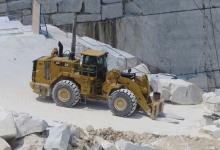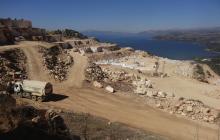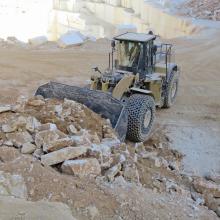
Many small companies started this industry and most have now been absorbed through successive acquisitions so that today the main players tend to be listed multi-national entities.
Essentially, quarrying occurs within a massive volcanic plane that has left a legacy of enormous mineral wealth. The area lies within the famed Bushveld Igneous Complex, home to the world’s largest reserves of platinum group metals, plus there are allied deposits of massive potential, such as vanadium. In fact, this is the Earth’s largest layered intrusion of its kind, divided by past geological surveys into the north, west, east and south limbs.
The Rustenburg Layered Suite, a basic plutonic phase of the intrusion, occurs within this multi-faceted geological mix. It is within this zone that some of the world’s best granite dimension stone products are mined, from a rich source that has been lying dormant for more than two billion years.
For Brits (east of Pretoria)-based quarry contractor, Classic Dimension Stone Mining, unlocking the value has been a lifelong passion with company head, Craffie Crafford. He was first being exposed to this business in 1989, initially as an employee for various dimension stone majors, having first earned his production experience in South Africa’s deep level gold mines.
Today Classic Dimension Stone Mining operates on two major Rustenburg district sites in this region for Kelgran Investments (starting from 2001) in which Italian dimension stone multi-national RED Graniti has a 50% interest.
These sites are in close proximity and comprise the Transvaal Quarry on farm Boschpoort, and the RIBST6 deposit on the farm Beestekraal.
Both are situated at elevation, providing sweeping vistas over the surrounding relatively flat terrain, with progressive mining of the hillsides working down to a maximum commercial depth of around 100m, the Zebra layer being at the cut-off.
The end product: Rustenburg Imperial, characterised by its distinctive greyish black colour is said to be “unique” to South Africa. The bulk of the end product, being R1 (graded as first choice material) is exported and distributed to markets that include continental Europe and Asia. (Other granite specifications are second choice and commercial grades.)
Overburden typically runs to around 5-6m. Thereafter, sourced material is clearly defined, comprising the B and A Reef, interspersed by a PX marker around 6m thick, which is mined as the commercial grade product. B and A reefs chiefly yield R1 product.
The B reef goes to an average depth of 30-35m thick, and the A Reef (separated by the PX band) then travels further down to another 60-65m to reach the maximum viable depth for dimension stone mining. Depending on the formation, the extraction approach typically entails slab mining using diamond wire saws and drills, backed by specialist earthmoving machines.
“Geological characteristics are defined as solid, semi-solid, and loose formations. In your loose and semi-solid horizons you don’t use diamond wire cutting, since you cannot drill clean holes through, so this involves conventional plug and feather drilling and block blasting techniques,” says Crafford.
“Final product recovery is optimally between 8-10% but sometimes lower than this, so as a contractor the goal is always to reduce your cost and up your yield through the most efficient mechanised methods, which in turn is dependent on optimal equipment selection and in this respect Caterpillar block handlers have always been an integral part of our extraction programme.”
Placed in perspective, and assuming a 10% recovery, it is necessary to mine around 90% of the in-situ material to yield a saleable 10% R1 product. For example, 300m³ of R1 dimension stone granite weighs in at around 1,200tonnes (or 4tonnes/m³) so that equates approximately to a total of 12,000tonnes mined of which 10,800tonnes is predominately waste discard.
On both the Transvaal and RIBST6 sites, large solid blocks, typically weighing in the vicinity of 800tonnes, and measuring around 10m long by 2m wide and 8m to 10m high, are separated from the working face by using a hydro-cushion pushing device.
Sometimes one of Classic Dimension Stone Mining’s two recently acquired Cat 336D L excavators will be used to either push or pull a block down. Weighing in at an operating weight of around 36,498kg, depending on the stick and bucket configuration, the Cat 336D L is powered by a Cat C9 engine developing a maximum net flywheel power of 200kW.
Main tasks for Classic Dimension Stone Mining’s Cat 336Ds entail the opening up and clearing of overburden, and the top cleaning of the slab faces, plus the transporting of diamond wire saw machines around the site.
“This is a very versatile machine with tremendous reserve power,” says Crafford.
The Cat 336Ds are in turn used to load waste material into awaiting articulated trucks for transfer to the dumps. As mined out areas are closed, this waste material is backfilled in terms of a strict and ongoing environmental management programme.
Once large blocks are removed from the face they are then washed clean and inspected for faults, stains or cracks. Saleable stone is then cut into smaller, more manageable blocks (always working along the grain) typically 3m long by 2m wide and up to 1.5m thick: however, the thickness can range from 0.6m to 2m. Thereafter these cut blocks are then lifted and transported by Classic Dimension Stone Mining’s Caterpillar 988 block handler fleet to the nearby dressing yards on site.
There the final preparation takes place, with workers trimming the blocks to the perfectly rectangular shape required for the downstream market. The longer lengths and widths are favoured by the construction industry, major applications including architectural cladding. On average trimmed blocks going to market weigh around 18tonnes.
“As with any dimension stone quarry worldwide, block handling loaders are the backbone of the operation, and in the case of the Cat 988 Series, these have been purpose-built for the ultimate lift and balance in transporting blocks on the front end forks, weighing up to 20tonnes,” explains Barloworld Equipment Cat sales professional, Michael Winterbottom, based in Isando, Johannesburg. (Barloworld Equipment is the Cat dealer for southern Africa.)
The Cat 988 wheeled loader was first launched by Caterpillar in 1963. Since then subsequent standard Cat 988 wheeled loader specifications and allied 988 block hander configurations have evolved over time.
Powered by a Cat C18 ACERT engine (net power 397kW as per ISO 14396), the Cat 988H block handler has a standard operating weight of around 57,276kg, with a straight tipping load of 38tonnes (and 33.4 tonnes articulated 37º). The block handling package includes a purpose-built linkage, larger lift and tilt cylinders, additional counterweight and a high rimpull transmission.
Previous generation units are in turn extremely capable, with Classic Dimension Stone Mining’s Cat 988F Series I and Series II units delivering high availability, having recording on average more than 30,000 hours, respectively, in service.
Dating back to the late 1990s they keep on delivering, thanks to Caterpillar’s in-built second and third life rebuild philosophy, with typical upgrades entailing engine and transmission overhauls, while the frame integrity has remained firmly intact despite the machines’ arduous operating conditions.
Cat 988 Series II loaders deliver a net power of 321kW, driven by a Cat 3408E engine, with an average operating weight of 45,678kg.
“As a contractor, it’s all about the cost per tonne with the overriding goal of upping your yield and ensuring the mining and delivery of marketable R1 or equivalent stone,” adds Crafford. “That all depends on sound quarry management together with the right machine mix. Thanks to our Cat 988s, we keep on delivering with great availability.”












